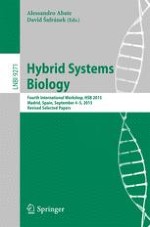This book constitutes the thoroughly referred post-workshop proceedings of the 4th International Workshop on Hybrid Systems biology, HSB 2015, held as part of the Madrid Meet 2015 event, in Madrid, Spain in September 2015. The volume presents 13 full papers together with 2 abstracts of invited sessions from 18 submissions. The scope of the HSB workshop is the general area of dynamical models in Biology with an emphasis on hybrid approaches — by no means restricted to a narrow class of mathematical models — and taking advantage of techniques developed separately in different areas.
